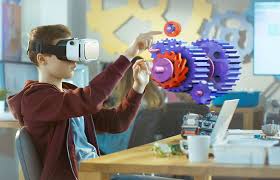
The landscape of education is undergoing a transformative period where technology like Augmented Reality (AR) is starting to play a pivotal role in how knowledge can be imparted, experienced, and understood. AR’s potential to revolutionize the traditional learning environments is boundless, offering staggering insights into the future of education.
Augmented Reality superimposes computer-generated images, offering an interactive experience of a real-world environment where objects reside in the current space but are enhanced or augmented. This immersive tool has found its way into classrooms worldwide, transforming them into dynamic learning spaces that foster engagement, boost motivation and enhance the learning process for students of all ages.
Incorporating AR into education allows for a multidimensional approach to teaching. It bridges the gap between theory and application by bringing abstract concepts to life. Students can visualize complex mechanisms, such as the human anatomy or astronomical phenomena, which can be difficult to grasp through traditional textbooks or 2D imagery. This not only helps students better understand the concepts but also retains their attention more effectively.
Moreover, AR in education provides customizability catering to different learning speeds and styles. As students interact with AR models, they can manipulate them in real-time, learning at their own pace. This level of interaction is invaluable for hands-on learning and for subjects that are inherently practical, such as engineering or medicine.
But AR’s impact goes beyond visualization and interaction; it can transform how assessments are conducted by providing teachers with real-world tasks that students can solve through AR experiences. For instance, an AR application can simulate a chemistry lab where students conduct virtual experiments—an ideal solution when actual lab resources are scarce or too dangerous for school settings.
Furthermore, through gamified learning experiences augmented by AR technology, education becomes more engaging and enjoyable. Gamified elements can lead to higher levels of participation and motivation among students who might otherwise be disinterested in conventional educational methods.
Possibly one of the most significant advantages is AR’s capacity to eliminate physical boundaries. With AR tools, historical sites, distant galaxies, or microscopic ecosystems can be explored without leaving the classroom. It enables students from all over the world to connect with places and artifacts they may never have the chance to physically visit.
However, while implementing AR technology in education systems holds exceptional promise for enhancing student outcomes and engagement levels, there are challenges as well. The most prevalent being the cost of equipment and creating content suitable for educational needs. In addition to technological constraints and accessibility barriers for some institutions.
In conclusion, Augmented Reality offers an insightful peek into the future of education—one that could redefine centuries-old teaching methodologies. As educators and policymakers increasingly recognize its value and versatility, we’re likely to see even more innovative ways this technology will be utilized for educational purposes. The opportunity it presents is vast: an overhaul in how topics are presented and absorbed; understanding human cognition in newer dimensions; equipping learners with skill sets aligned with a technology-driven future—all while making education more accessible and engaging than ever before. The promise of AR in shaping minds is not just staggering; it’s profoundly transformative.
